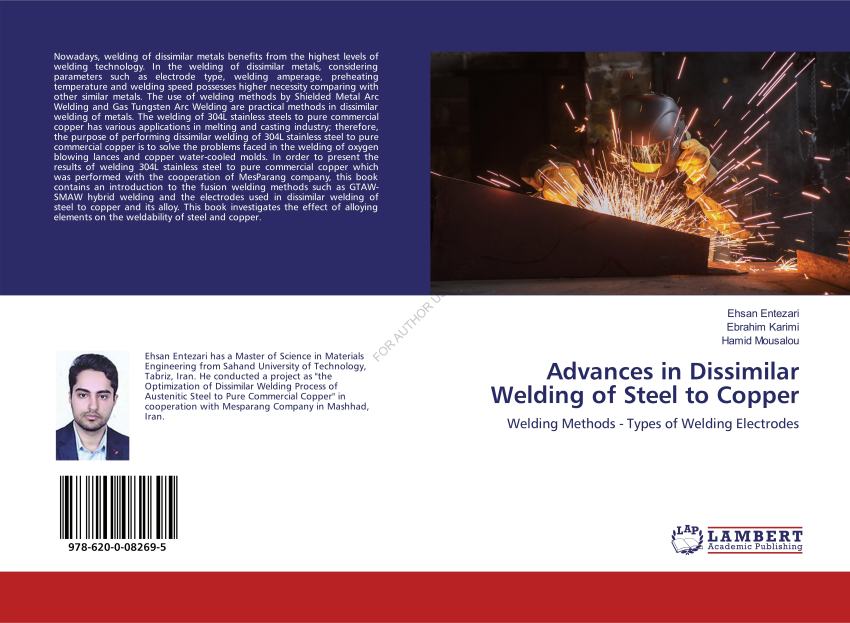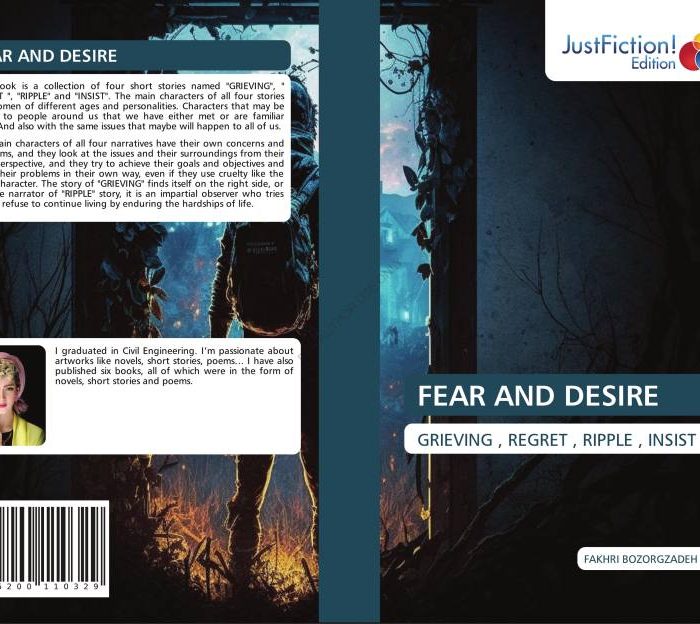کتاب Advances in Dissimilar Welding of Steel to Copper
۱۴۰,۰۰۰ تومان Original price was: ۱۴۰,۰۰۰ تومان.۹۹,۱۲۰ تومانCurrent price is: ۹۹,۱۲۰ تومان.
| تعداد صفحات | 61 |
|---|---|
| شابک | 978-620-0-08269-5 |
| انتشارات |



کتاب Advances in Dissimilar Welding of Steel to Copper – پیشرفتها در جوشکاری غیرمشابه فولاد به مس
کتاب Advances in Dissimilar Welding of Steel to Copper اثری تخصصی است که به بررسی فناوریها، تکنیکها و چالشهای جوشکاری مواد غیرمشابه، بهویژه فولاد و مس، میپردازد. این کتاب مرجعی ارزشمند برای مهندسان، محققان و دانشجویان علاقهمند به علم مواد و مهندسی جوشکاری است.
درباره کتاب Advances in Dissimilar Welding of Steel to Copper
این کتاب بهصورت جامع به مسائل فنی و علمی مرتبط با جوشکاری فولاد به مس پرداخته و راهکارهایی نوآورانه برای غلبه بر مشکلات این فرآیند ارائه میدهد. مباحثی همچون خواص مواد، مکانیسمهای تشکیل اتصالات، کنترل حرارتی و تکنیکهای پیشرفته جوشکاری در این اثر مورد تحلیل قرار گرفته است.
موضوعات کلیدی کتاب
- رفتار متالورژیکی مواد: بررسی خواص فیزیکی و شیمیایی فولاد و مس در جوشکاری.
- فناوریهای نوین جوشکاری: معرفی تکنیکهایی مانند جوشکاری لیزری، اصطکاکی و الکتریکی.
- چالشهای جوشکاری غیرمشابه: تحلیل مشکلاتی همچون تفاوت در هدایت حرارتی و انبساط حرارتی.
- کنترل و بهینهسازی فرآیند: راهبردهای کاهش تنشهای حرارتی و افزایش کیفیت اتصال.
- کاربردهای صنعتی: استفاده از تکنیکهای جوشکاری غیرمشابه در صنایع مختلف مانند خودروسازی و الکترونیک.
ویژگیهای برجسته کتاب Advances in Dissimilar Welding of Steel to Copper
- رویکرد تخصصی و علمی: تحلیل عمیق اصول و فرآیندهای جوشکاری غیرمشابه.
- ارائه مطالعات موردی: ارائه نمونههای واقعی از پروژههای جوشکاری موفق.
- تصاویر و نمودارهای گویا: استفاده از تصاویر و دادههای کاربردی برای درک بهتر مطالب.
- پوشش جامع: ارائه دیدگاهی کامل از مبانی تا پیشرفتهای جدید در این حوزه.
چرا کتاب Advances in Dissimilar Welding of Steel to Copper را بخوانید؟
این کتاب فرصتی بینظیر برای یادگیری و بهبود مهارتهای تخصصی در زمینه جوشکاری غیرمشابه است. اگر به دنبال درک عمیقتر از علم مواد و تکنیکهای پیشرفته در این حوزه هستید، این اثر میتواند منبعی قابلاعتماد و کاربردی باشد.
مخاطبان کتاب Advances in Dissimilar Welding of Steel to Copper
- مهندسان و پژوهشگران جوشکاری: برای یادگیری فناوریهای نوین و کاربردهای صنعتی.
- دانشجویان علوم مواد و مهندسی مکانیک: برای درک مبانی و تکنیکهای پیشرفته در جوشکاری.
- صنعتگران و متخصصان تولید: برای بهبود فرآیندهای جوشکاری و افزایش بهرهوری.
- علاقهمندان به نوآوریهای صنعتی: برای آشنایی با چالشها و راهحلهای جوشکاری غیرمشابه.
سفارش کتاب Advances in Dissimilar Welding of Steel to Copper
برای خرید کتاب Advances in Dissimilar Welding of Steel to Copper و دسترسی به اطلاعات ارزشمند در زمینه جوشکاری غیرمشابه، به بخش فروشگاه سایت مراجعه کنید یا با ما تماس بگیرید. این کتاب مرجعی کلیدی برای موفقیت در پروژههای پیچیده جوشکاری و ارتقای دانش فنی شما خواهد بود.
1. کتاب “Advances in Dissimilar Welding of Steel to Copper” به چه موضوعاتی پرداخته است؟ 🔧
پاسخ: این کتاب به پیشرفتهای جوشکاری فلزات مختلف بهویژه جوشکاری فولاد به مس پرداخته است. کتاب شامل روشهای جوشکاری، انتخاب الکترودها، تاثیر عناصر آلیاژی بر قابلیت جوشکاری، و همچنین روشهای مختلف جوشکاری برای اتصال فولاد و مس و آلیاژهای آنها میباشد.
2. در فصل اول، “An Introduction to the Dissimilar Welding” چه مفهومی مطرح میشود؟ ⚙️
پاسخ: در این فصل، معرفی جوشکاری فلزات مختلف (دیسیمیلار جوینینگ) ارائه شده است. این نوع جوشکاری به فرآیند اتصال فلزاتی اطلاق میشود که از نظر ترکیب شیمیایی و خواص فیزیکی با هم تفاوت دارند، مانند جوشکاری فولاد به مس.
3. در فصل دوم، چه تاثیری عناصر آلیاژی بر جوشکاری دارند؟ ⚙️
پاسخ: در این فصل، تاثیر عناصر آلیاژی بر قابلیت جوشکاری فولاد و مس و آلیاژهای آنها بررسی شده است. برای فولادهای زنگنزن، این تاثیرات میتوانند شامل بهبود خواص جوشکاری و تشکیل ساختارهای میکروساختاری خاص باشند. برای مس و آلیاژهای آن نیز این تاثیرات میتواند به خواص فیزیکی و شیمیایی جوش بستگی داشته باشد.
4. در فصل سوم، “Fusion Welding Methods” چه روشهایی برای جوشکاری معرفی شدهاند؟ 🔥
پاسخ: در این فصل، روشهای جوشکاری ذوبی برای اتصال دائمی فولادهای زنگنزن و مس و آلیاژهای آنها معرفی شده است. روشهای جوشکاری قوس فلزی با الکترود پوششدار (SMAW)، جوشکاری قوس تنگستن گازی (GTAW)، و جوشکاری قوس فلزی گازی (GMAW) از جمله روشهای مطرح شده هستند.
5. در فصل چهارم، “Electrodes in Fusion Welding” به چه موضوعی پرداخته میشود؟ ⚡
پاسخ: این فصل به الکترودها در جوشکاری ذوبی اختصاص دارد. در این بخش، انواع الکترودهای مناسب برای جوشکاری فولادهای زنگنزن، مس و آلیاژهای آنها و همچنین الکترودهایی که برای جوشکاری دیسیمیلار (فولاد به مس) مناسب هستند، بررسی شدهاند.
6. در فصل پنجم، “Defects and Approaches to Prevent their Formation” چه نقصهایی در جوشکاری دیسیمیلار بررسی شده است؟ ❌
پاسخ: در این فصل، نقصهای ممکن در جوشکاری دیسیمیلار فولاد به مس و آلیاژهای آنها بررسی شده است. این نقصها میتوانند شامل ترکهای جوش، حفرهها و ناسازگاریهای میکروساختاری باشند. همچنین، روشهایی برای پیشگیری از این نقصها در فرآیند جوشکاری ارائه شده است.
7. فصل ششم درباره چه موضوعی صحبت میکند؟ 🔬
پاسخ: فصل ششم به روشهای عملی جوشکاری دیسیمیلار فولاد زنگنزن 304L به مس تجاری خالص پرداخته است. این بخش شامل بررسی مواد و روشهای مورد استفاده برای جوشکاری، مطالعه میکروساختاری جوشها، خواص مکانیکی جوشها، و مقاومت به خوردگی جوشهای حاصل از این فرآیند است.
8. در فصل ششم، چه مطالعاتی در زمینه خواص مکانیکی و خوردگی انجام شده است؟ ⚙️🛠️
پاسخ: در این فصل، مطالعاتی در زمینه خواص مکانیکی جوشهای دیسیمیلار فولاد 304L به مس تجاری خالص انجام شده است. این مطالعات به ارزیابی مقاومت کششی، سختی و رفتار در برابر خوردگی در جوشهای بهدستآمده پرداخته است. هدف این مطالعات تعیین تأثیر فرآیند جوشکاری بر عملکرد مکانیکی و مقاومت به خوردگی جوشها است.
9. چه نتیجهگیریهایی در مورد جوشکاری دیسیمیلار فولاد 304L به مس تجاری خالص انجام شده است؟ 🏁
پاسخ: در پایان فصل ششم، نتیجهگیریهایی ارائه شده است که بر اهمیت انتخاب صحیح روشهای جوشکاری و مواد برای حصول جوشهای با کیفیت بالا تأکید دارد. جوشکاری دیسیمیلار فولاد 304L به مس تجاری خالص میتواند چالشهایی از نظر ایجاد نقصهای میکروساختاری و تغییرات خواص مکانیکی ایجاد کند، اما با انتخاب دقیق روش و الکترود مناسب میتوان به جوشهای پایدار و مقاوم دست یافت.
10. منابع و مآخذ کتاب در کجا قرار دارند؟ 📚
پاسخ: منابع و مآخذ کتاب در انتهای فصل ششم آورده شده است و شامل مقالات علمی، کتب و منابع معتبر در زمینه جوشکاری دیسیمیلار و فولاد و مس میباشد که برای اطلاعات بیشتر و مطالعات تکمیلی قابل استفاده هستند.
| تعداد صفحات | 61 |
|---|---|
| شابک | 978-620-0-08269-5 |
| انتشارات |
محصولات مشابه
-
کتاب The Grey Stories
۱۴۰,۰۰۰ تومانOriginal price was: ۱۴۰,۰۰۰ تومان.۱۰۳,۶۰۰ تومانCurrent price is: ۱۰۳,۶۰۰ تومان. -
کتاب Determining indicators of the underground economy in Iran
۱۴۰,۰۰۰ تومانOriginal price was: ۱۴۰,۰۰۰ تومان.۱۰۳,۶۰۰ تومانCurrent price is: ۱۰۳,۶۰۰ تومان. -
کتاب Silver Nanoparticles: Synthesis and Their Biological Applications
۲۱۰,۰۰۰ تومانOriginal price was: ۲۱۰,۰۰۰ تومان.۱۴۸,۶۸۰ تومانCurrent price is: ۱۴۸,۶۸۰ تومان. -
کتاب FEAR AND DESIRE
۱۴۰,۰۰۰ تومانOriginal price was: ۱۴۰,۰۰۰ تومان.۹۹,۱۲۰ تومانCurrent price is: ۹۹,۱۲۰ تومان.






